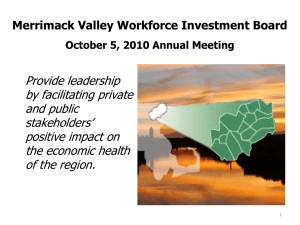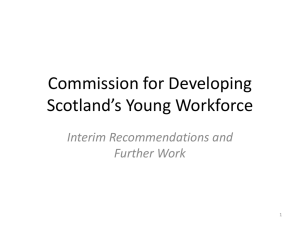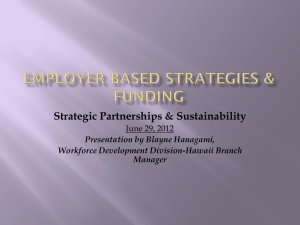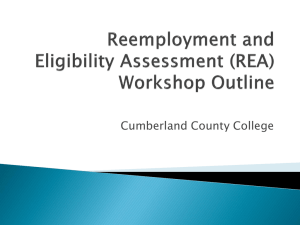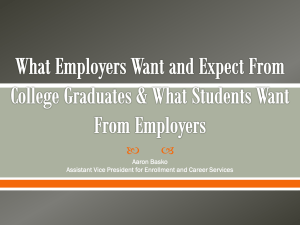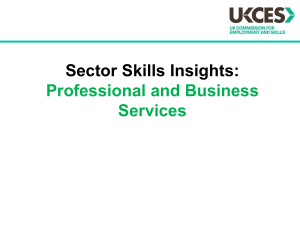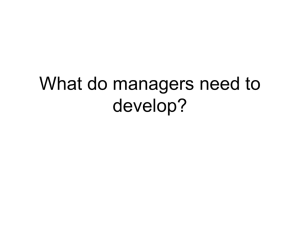Skills Gap Presentation 2011-01-25
advertisement
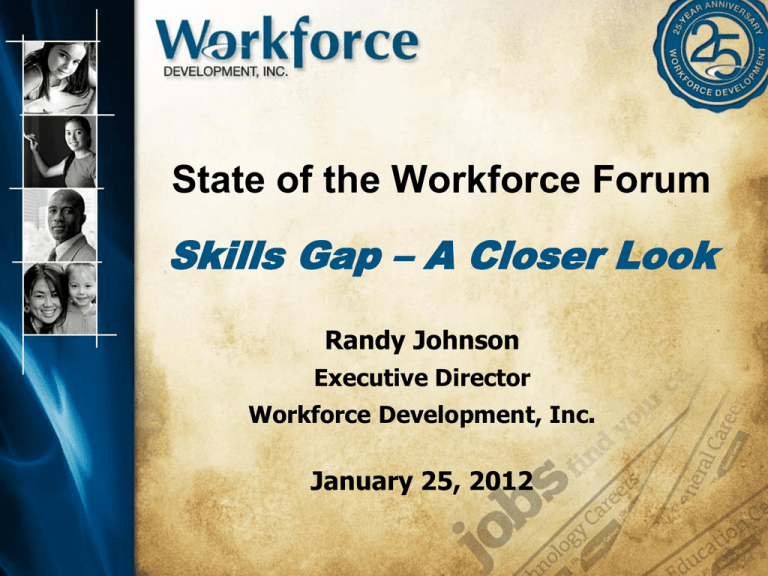
State of the Workforce Forum Skills Gap – A Closer Look Randy Johnson Executive Director Workforce Development, Inc. January 25, 2012 Skills Gap Survey Background • Continuation of last year’s Talent Development Call to Action • Governor’s Skills Gap Conference • Need to validate assumptions formally • Reports on labor/skills shortages growing Working with a Changing Labor Pool Projected Growth in Working Age Population in SEMN, 2000 - 2030 25000 20000 15000 10000 5000 0 -5000 2005 2010 2015 2020 2025 2030 Skills Gap Survey - Design • Targeted living wage employers who have hired in the last 2 years • 137 employers – 1% of employers – 27% of jobs • Surveys conducted in person and online between 12/6/11 and 1/17/12 Skills Gap Survey - Sectors Manufacturing Other Healthcare Professional Services Food Processing Public Sector Transportation Construction Review of Data Predicted job growth in 2012 • 30% expect growth • 60% expect to stay about the same • 10% expect to cut back Review of Data Most effective recruitment methods (other than IBM & Mayo) 1. 2. 3. 4. 5. Promote from within Employee referrals Business associate referrals Internet WorkForce Centers/MN Works Review of Data Recruitment tools: • 65% report the internet has become an important part of their recruitment strategy • 47% currently post openings in MN Works • 25% use social media as a recruitment tool (Linked-In/Facebook) • 34% use recruiting specialists to find employees for hard-to-fill positions Review of Data Labor shortage indications • 15% are now willing/able to pay hiring bonus • 49% had to re-post an opening in the last year due to a lack of qualified applicants • 31% report interviewing candidates for positions not open – building a pool • 41% are concerned about the prospect of essential employees retiring in the next few years Review of Data Applicant and employee skills • 61% of employers conduct pre-employment testing • 33% of employers believe that the applicant pool does not possess the necessary skills • 20% of employers believe their current employees do not have the technical skills needed to grow the organization Review of Data Most common soft skill deficiencies • • • • Communication skills Working as a team Problem solving skills Basic employability/motivation Review of Data Most common technical skill deficiencies – manufacturing • • • • • • Machine operation, set-up, maintenance Safety Welding Quality assurance methods Electronic diagnostics Basic computer skills Review of Data Locating and using information – most common deficient essential skills: • Being able to read and compare graphs • Being able to locate necessary information on a table • Knowing how to set up and read a spreadsheet • Being able to distinguish bias in data presented Review of Data STEM skills: most employers found applicants’ basic STEM skills adequate, but could use more: • • • • • • Ability to measure; translate measurements Statistical analysis Electricity Chemistry Physics Metallurgy Review of Data Methods used to deliver effective training to employees: • • • • • 68% use private colleges 61% use community colleges 41% use industry/trade associations 37% use universities 23% use private consultants/vendors Review of Data Other observations: • 80% of employers have never heard of “Project Lead the Way,” but the majority want more information • 35% of employers would be willing to sponsor an intern and an additional 22% want more information Review of Data Other observations: • 55% of employers are interested in an onthe-job training contract • 60% of employers want more information on tax credits for veterans • 20% want to build a “Smart Buyer-Supplier Network” Summary of Findings We can validate Anthony Carnivale’s study suggesting 70% of future jobs will require advanced training beyond high school • 86% of all jobs in the survey required more than a high school education to start • 44% of employers – other than IBM & Mayo – required advanced training • However, nearly 100% of those surveyed said on-going training is essential Summary of Findings We verified the perspective of the current Atlantic Monthly article, “Making it in America” • The manufacturing industry is alive and well in this country, but too many young people don’t know it • There is a growing gap between the skilled and un-skilled manufacturing employees http://www.theatlantic.com/magazine/archive/2012/01/making-it-in-america/8844/ Summary of Findings We have found that, generally speaking, when it comes to the importance and the relationship between technical skills and soft skills… employers hire for attitude and fit, and then train for job-specific skills Summary of Findings Our results agree with a survey by FTI Consulting: • A majority of businesses find the higher education system good to excellent, with room to improve: – Response time – Rigor – Relevance to employer’s needs Final Thoughts • The content of what K-12 teaches may be less important than how it’s taught – Inquiry-based education gets more buy-in • If we need everyone in the workforce, and communication/social skills are critical, then we may need to focus on student interaction and differentiated instruction. Flipped classrooms? Final Thoughts Many of our critical industries and occupations are invisible to the public, especially in the manufacturing sector. We need to pursue a regional marketing and awareness campaign. Final Thoughts • An increased use of internships/OJTs within the higher education system would be beneficial • Giving “credit for prior learning” could jump start some people with their education • A close working relationship between the MnSCU system and workforce development service providers would benefit both The right people for the right job at the right time Contact Information: Randy Johnson Executive Director Workforce Development, Inc. Email: rjohnson@wfdi.ws Website: http://www.workforcedevelopmentinc.org

